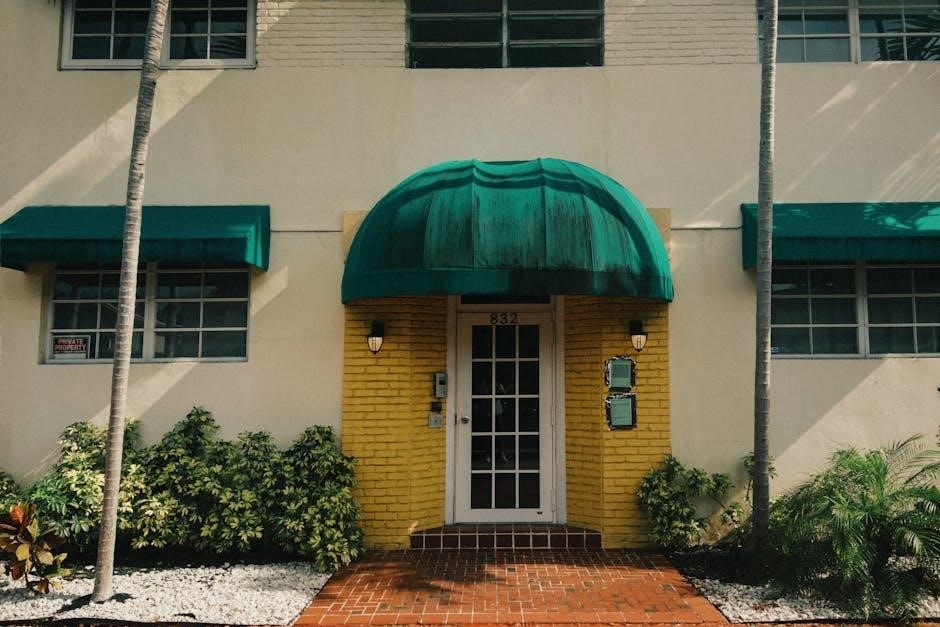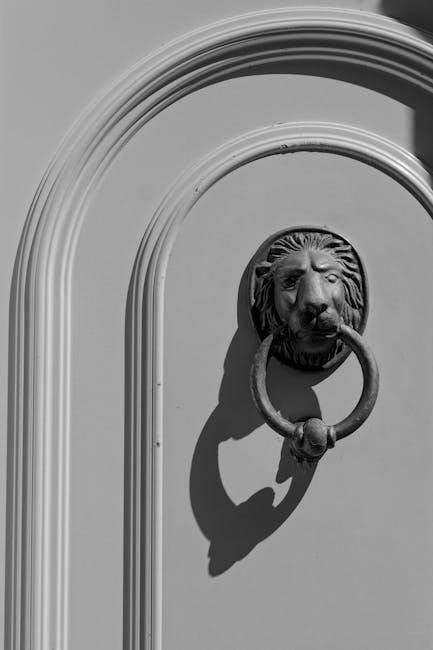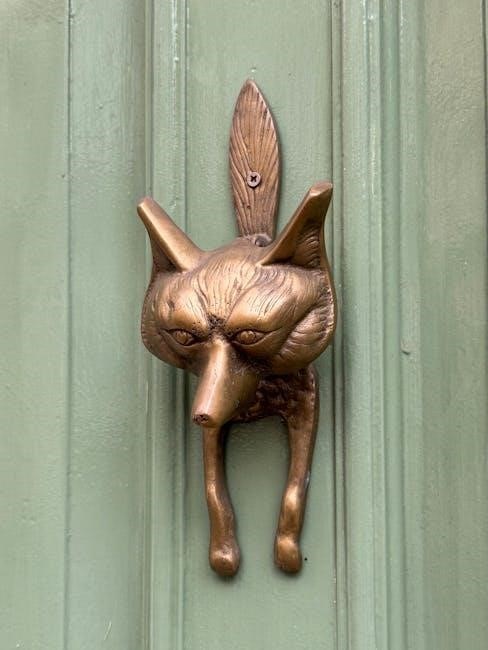A door closer ensures smooth and controlled door closure, essential for functionality, safety, and energy efficiency. Proper adjustment guarantees optimal performance, preventing issues like improper latching or excessive force.
1.1. What is a Door Closer?
A door closer is a mechanical device designed to automatically close doors after they have been opened. It ensures consistent and controlled closure, providing convenience, safety, and energy efficiency. Typically mounted on the door or its frame, door closers use hydraulic or pneumatic mechanisms to regulate closing speed and force. They are essential for maintaining proper door function, preventing air leaks, and reducing wear and tear. Door closers are commonly found in residential, commercial, and industrial settings, offering reliability and durability. By automating the closing process, they enhance accessibility and ensure doors remain securely shut when not in use, contributing to overall building efficiency and security. Proper adjustment is crucial for optimal performance.
1.2. Why Adjust a Door Closer?
Adjusting a door closer is essential to ensure proper door function, safety, and energy efficiency. A poorly adjusted closer can lead to issues like doors not closing fully, excessive force, or rapid closing, which may cause accidents or damage. Proper adjustment ensures the door closes smoothly, latches securely, and maintains consistent speed. It also helps prevent wear and tear on the door and frame, reducing long-term maintenance costs. Additionally, adjusting the closer can improve accessibility by controlling the force required to open or close the door. Regular adjustments are necessary to accommodate changes in door alignment or usage patterns, ensuring optimal performance and reliability over time. This maintains the door’s functionality and extends its lifespan.

Tools and Safety Precautions
Essential tools include a screwdriver and pliers. Wear safety gloves and goggles. Exercise caution with spring tension to avoid injury. Work carefully to prevent accidents.
2.1. Essential Tools for Adjustment
To adjust a door closer effectively, you’ll need a few essential tools. A screwdriver is the primary tool, as most adjustments involve turning screws. Pliers may be necessary for gripping small components. A hex key or Allen wrench could be required for specific models. Additionally, a pair of gloves can provide grip and protection while handling the door closer. For visibility, a flashlight might be helpful if working in poorly lit areas. Safety goggles are recommended to protect your eyes from any potential debris. Ensure all tools are readily accessible before starting the adjustment process to avoid delays. Proper tools are crucial for precise adjustments and safe handling.
2.2. Safety Guidelines
When adjusting a door closer, safety is paramount to avoid accidents or injuries. Always wear protective gear, including gloves and safety goggles, to shield yourself from potential hazards. Ensure the door is secure and cannot swing unpredictably during adjustments. If the door is heavy or large, consider having someone assist to hold it in place. Disconnect any power sources if the door closer is electrically powered. Never tamper with the device while the door is in motion. Keep loose clothing and long hair tied back to prevent entanglement. Follow the manufacturer’s instructions closely and avoid over-tightening screws, which could damage the mechanism. By adhering to these guidelines, you can ensure a safe and successful adjustment process.

Understanding Your Door Closer
A door closer is a mechanical device that automatically closes doors, ensuring security and energy efficiency. Understanding its components and functionality is crucial for effective adjustment.
Door closers come in various types to suit different needs. Surface-mounted closers are the most common, installed on the door’s surface, while concealed closers are hidden within the door or frame, offering a sleek look. Overhead closers are mounted on the door frame and ideal for heavy-duty use. Floor-spring closers are embedded in the floor, providing a minimalist aesthetic. Additionally, some closers are specialized for specific applications, such as fire doors or high-traffic areas. Each type has unique features, and selecting the right one depends on factors like door weight, usage frequency, and desired appearance. Proper identification ensures effective adjustment and functionality. A door closer consists of several key components essential for its operation. The cylinder houses the spring and hydraulic fluid, controlling the closing motion. Adjustment screws regulate the closing speed and latching force, allowing customization. The backcheck valve prevents excessive door swing, protecting the door and frame from damage. Mounting brackets secure the closer to the door or frame, ensuring proper alignment. The piston and rod connect the cylinder to the door, facilitating smooth movement. Seals within the cylinder maintain fluid containment and ensure consistent performance. Understanding these components is crucial for effective adjustment and troubleshooting. Each part plays a vital role in the closer’s functionality and longevity. Regular maintenance of these components ensures optimal door operation. Before adjusting, remove the cover to access internal components. Locate adjustment screws for closing speed and latching force; Ensure all valves are in the correct position for precise tuning. To begin, gather your tools, including a screwdriver and work gloves. Locate the screws securing the cover, typically found around the edges of the door closer. Remove these screws carefully with your screwdriver to avoid stripping the heads. Gently lift the cover, taking care not to force it and possibly damage the closer. Once removed, set the cover aside and ensure the area is clear for accessing the internal adjustment screws. This step is crucial for safely and effectively making the necessary adjustments. After removing the cover, locate the adjustment screws inside the door closer. These screws are typically labeled or positioned to control specific functions. The closing speed screw regulates how fast the door closes, while the latching speed screw adjusts the final movement before the door latches. Some closers may also have a backcheck adjustment screw to prevent the door from opening too wide. Identify each screw’s purpose by referring to the closer’s manual or markings. Ensure you handle the screws carefully to avoid damage. Use a screwdriver to make precise adjustments, and avoid over-tightening, which could impair functionality. Properly locating these screws is essential for effective adjustment. Adjusting the closing speed ensures the door shuts smoothly and safely. Proper speed settings prevent slamming or slow closure, enhancing both functionality and user experience. Locating the closing speed adjustment screw is the first step in fine-tuning your door closer. Typically found on the main cylinder or arm, it controls the door’s closing speed. To adjust the closing speed, turn the screw clockwise to slow down the door or counterclockwise to increase the speed. Use a screwdriver for precise control. After each adjustment, test the door to ensure it closes smoothly and at the desired pace. Avoid over-tightening, as this may damage the mechanism or affect performance. Adjusting the latching speed ensures the door closes firmly and securely. Proper adjustment prevents issues like incomplete latching or excessive force, maintaining smooth operation and safety. To locate the latching speed screw, first remove the door closer cover by unscrewing it. This exposes the internal components. The latching speed screw is typically found near the valve responsible for controlling the final stages of door closure. It may be labeled or positioned adjacent to the closing speed adjustment. Ensure you identify it correctly to avoid altering other settings. Once located, you can proceed to fine-tune the latch speed for optimal performance. Proper identification is crucial to achieve the desired adjustment without affecting other functionalities of the door closer. After locating the latching speed screw, use a screwdriver to make precise adjustments. Turning the screw clockwise typically slows down the latch speed, while counterclockwise increases it. Start with small turns and observe the door’s closing action. If the door latches too quickly, it may slam shut, potentially causing damage or injury. Conversely, if it latches too slowly, the door might not secure properly, posing security risks or allowing air leakage. Continue adjusting incrementally until the desired balance between safety and functionality is achieved. Ensure to test the door thoroughly after each adjustment to confirm proper latching and smooth operation. The backcheck adjustment ensures the door doesn’t swing too far, preventing damage. Turning the backcheck valve adjusts resistance, controlling the door’s opening range for safety and durability. The backcheck function in a door closer is designed to control the door’s swing and prevent it from opening too widely. This feature is essential for protecting the door and surrounding structure from damage caused by excessive force or wind. When the door reaches a certain angle during opening, the backcheck engages, creating resistance to slow down the movement. This not only safeguards the door frame and adjacent walls but also ensures smoother operation. Proper adjustment of the backcheck is crucial to balance between ease of access and protection, making it a key aspect of door closer maintenance. Regular checks ensure optimal performance and longevity. To adjust the backcheck valve, locate it on the door closer. Turn the valve clockwise to increase resistance, slowing the door’s opening beyond a certain point. Counterclockwise turns reduce resistance. Test the door’s swing after each adjustment to ensure it stops at the desired angle without slamming or exceeding the intended range. Proper adjustment prevents damage to the door and frame while maintaining smooth operation. Fine-tune gradually, as over-tightening can restrict movement. Always test the door thoroughly after adjustments to confirm the backcheck function performs as intended, providing the right balance between control and ease of use. Test the door to ensure it closes fully and the latch engages securely. Repeat the process several times, observing smooth operation without excess noise or resistance. After adjustments, inspect the door’s closing force to ensure it operates smoothly and safely. Open the door fully and allow it to close naturally. Observe if it moves steadily without excessive force or resistance. A properly adjusted door closer should exert consistent pressure, neither too heavy nor too light. Test the door multiple times to confirm reliability. If the door feels too forceful, it may require reducing the closing force by adjusting the relevant screws. Conversely, if the door closes too slowly or weakly, increase the force slightly. Ensure the closing force complies with accessibility standards to prevent injuries while maintaining secure latching. Proper force ensures both functionality and safety. After adjusting the door closer, verify that the door latches securely into the frame. Open the door fully and allow it to close naturally. Listen for the distinct “click” sound as the latch engages with the striker plate. Ensure the door aligns properly with the frame to prevent misalignment issues. If the latch does not engage fully, the door may not close securely, leading to potential security or sealing problems. Fine-tune the latching speed or alignment if necessary. Repeat the test several times to confirm consistent latching performance. Proper latching ensures the door functions as intended, providing both security and energy efficiency over time. Common issues include doors not closing completely, closing too fast or slow, or failing to latch properly. These problems often result from improper adjustments or worn components; A door not closing completely can be due to insufficient closing force, misaligned brackets, or obstructions. Check for proper door alignment and ensure no objects block the path. Regular maintenance and proper adjustments can resolve this issue, ensuring smooth and complete door closure every time. If the door closes too fast or too slow, the closing speed adjustment screw needs fine-tuning. Turning it clockwise slows the door, while counterclockwise increases speed. Ensure the door closes smoothly and safely by making incremental adjustments and verifying the result each time. A door that fails to latch properly can be due to misalignment or incorrect latch speed. Check the door frame and strike plate for alignment issues. Proper latching ensures security and prevents wear on the door and frame. Regularly inspect and lubricate the door closer to ensure smooth operation. Clean dust and debris from the mechanism to maintain efficiency and longevity. Lubricating your door closer is crucial for maintaining its performance. Use a high-quality silicone-based lubricant to grease moving parts like hinges and pivot points. Avoid using oil-based products as they can attract dust and dirt, leading to mechanical issues. Apply lubricant every 6-12 months or when you notice increased resistance or noise during operation. Proper lubrication ensures smooth closing and latching, preventing wear and tear. Always refer to the manufacturer’s guidelines for specific lubrication recommendations tailored to your door closer model. Regular maintenance helps extend the lifespan and reliability of the mechanism. Cleaning your door closer regularly is essential for its optimal function. Dust and dirt accumulation can hinder its performance, so gently wipe the mechanism with a soft cloth. Avoid using harsh chemicals or abrasive materials that may damage the finish or components. For stubborn grime, a mild soap solution can be used, but ensure the area is thoroughly dried afterward. Pay special attention to the arm, spring, and adjustment screws. Regular cleaning prevents corrosion and maintains the door closer’s efficiency. This simple maintenance step helps ensure smooth operation and longevity of the mechanism, keeping your door functioning as intended year-round. Adjusting a door closer is a manageable task with the right tools and understanding. By following the outlined steps and maintaining regular upkeep, you ensure smooth, efficient door operation. Proper adjustments enhance safety, reduce wear, and prolong the closer’s lifespan. Remember to test the door after each modification to confirm optimal performance. Troubleshooting common issues and keeping the mechanism clean further support its reliability. With these guidelines, you can confidently maintain and adjust your door closer, ensuring it functions seamlessly for years to come. Always refer to manufacturer instructions for specific models, as slight variations may exist. Happy adjusting!3.1. Types of Door Closers
3.2. Key Components of a Door Closer

Preparing for Adjustment
4.1. Removing the Cover
4.2. Locating Adjustment Screws

Adjusting the Closing Speed
5.1. Identifying the Closing Speed Adjustment Screw
5.2. Turning the Screw to Adjust Speed

Adjusting the Latching Speed
6.1. Locating the Latching Speed Screw
6.2. Fine-Tuning the Latch Speed

Backcheck Adjustment
7.1. Understanding the Backcheck Function
7.2. Adjusting the Backcheck Valve

Testing the Door After Adjustments
8.1. Checking the Closing Force
8.2. Ensuring Proper Latching

Common Issues and Solutions
9.1. Door Not Closing Completely
9.2. Door Closing Too Fast or Too Slow
9.3. Door Not Latching Properly

Maintenance Tips
10.1. Regular Lubrication
10.2. Cleaning the Door Closer

No Responses